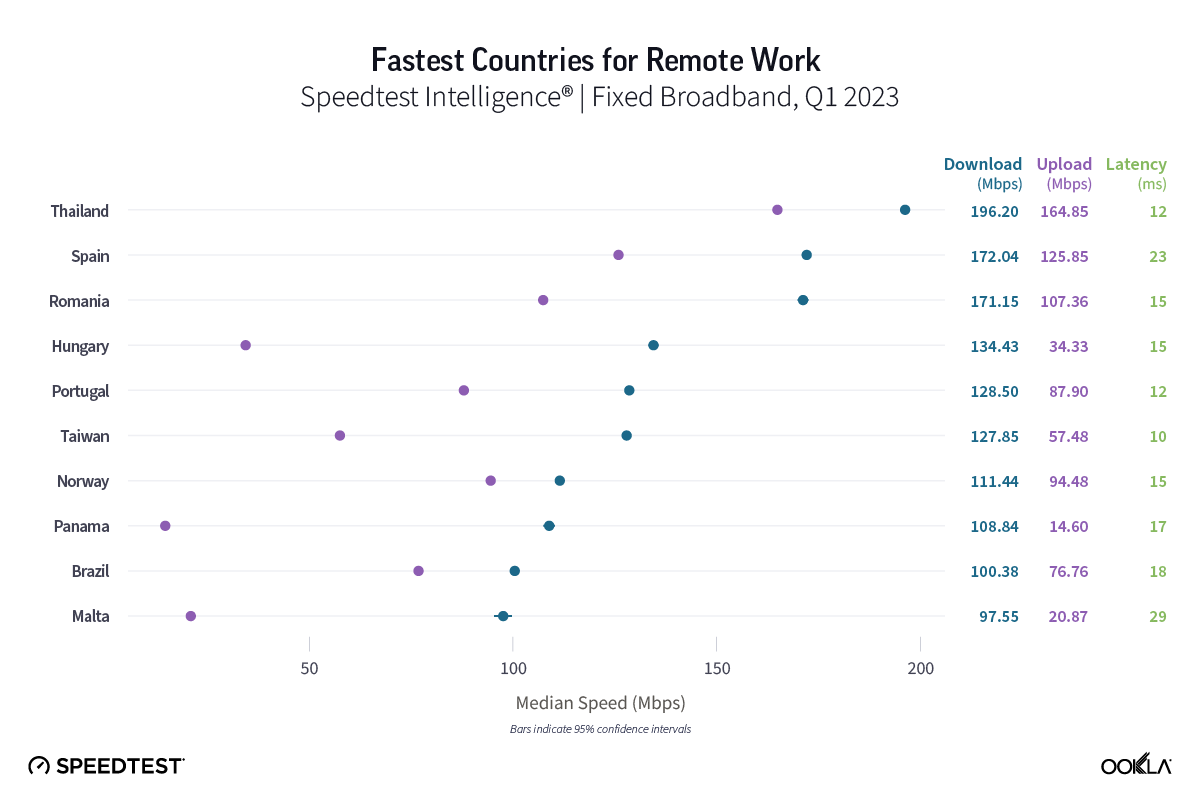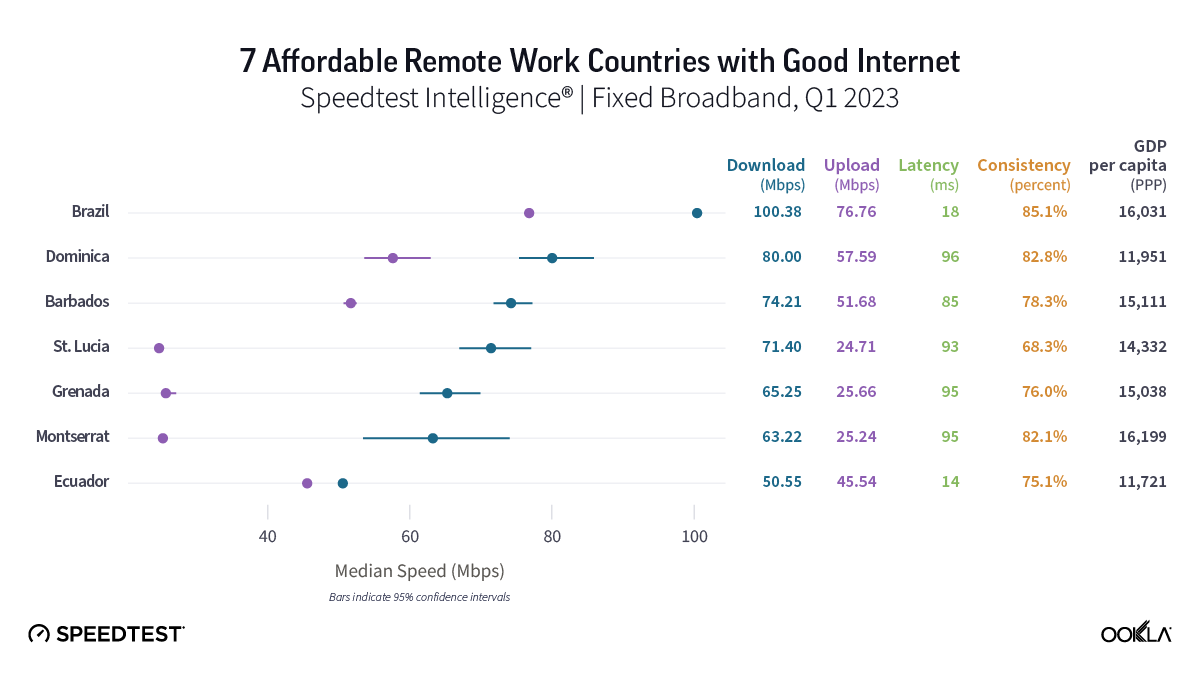ISPs in the Caribbean have helped drive a step-change in performance across the region over the past four years. Fiber is at the forefront of this change, helping drive performance gains in terms of throughput and latency in leading markets such as Trinidad and Tobago, Bermuda, and the Cayman Islands, while Starlink’s LEO service is gaining a foothold in a number of islands too. Outside the leading Caribbean markets, performance varies significantly, but even among those lagging the regional average are advancing rapidly.
Key takeaways
- Growing availability of faster broadband across the Caribbean. The last four years have seen a transformation in broadband performance in the Caribbean. Across the markets in this analysis, network Consistency – the share of Speedtest samples exceeding a threshold of 25 Mbps download and 3 Mbps upload – increased from 45.3% in Q1 2020, to 73.3% as of Q1 2024.
- Fiber adoption driving performance gains. Trinidad and Tobago, Bermuda, and the Cayman Islands led the Caribbean region on fixed broadband performance, recording median download speeds of 110.26 Mbps, 109.79 Mbps, and 104.88 Mbps, respectively during Q1 2024. Strong fiber performance from a number of ISPs, including Digicel+ (across a range of markets), Amplia (Trinidad and Tobago), as well as Flow, Logic, and C3 Pure Fiber (Cayman Islands), helped drive this, with all recording median download speeds approaching or above 100 Mbps.
- Latency performance varies hugely across the Caribbean. Key for real-time applications such as online gaming and video calling, latency performance varied significantly across the region. Thanks to the availability of fiber to most broadband users, markets such as Trinidad and Tobago hit median latency lows of just 15 ms in Q1 2024, while at the other end of the scale, markets such as Aruba and Haiti struggled with median latency approaching 100 ms.
- Markets behind the curve are quickly catching up. The majority of Caribbean markets currently below the regional average for fixed network Consistency are catching up fast, led by markets such as the Dominican Republic, Sint Maarten, and the British Virgin Islands, which all increased network Consistency by more than 25 percentage points over the last two years.
Fixed network performance varies dramatically across the Caribbean
Ookla Speedtest Intelligence® data shows a wide disparity in median fixed broadband performance across Caribbean markets, ranging from lows of 2.72 Mbps and 25.21 Mbps in Cuba and Sint Maarten respectively, to highs of 110.26 Mbps and 109.79 Mbps in Trinidad and Tobago, and Bermuda respectively. Median upload performance mimicked this trend, with a low of 1.02 Mbps for Cuba and a high of 89.15 Mbps in the Cayman Islands.
Latency performance showed even greater variance, with some markets being able to access high-speed international links, and with others relying on multiple hops of undersea cables. Eight of the markets we examined recorded median multi-server latency below 50ms, with Trinidad and Tobago leading with 15ms, followed closely by Curaçao with 16ms. At the other end of the scale, a cluster of nine markets recorded latency ranging from 71 ms to 95 ms, while Cuba was the only market with median latency greater than 100 ms, recording 133 ms in Q1 2024. This marks an improvement year-on-year, down from 164 ms in Q1 2023, with the Arimao submarine cable (connecting Cuba to Martinique), helping drive some improvement, however, the island’s aging telecoms infrastructure continues to hold it back.
Fiber is the natural next step for many Caribbean ISPs
A number of Caribbean ISPs, led by groups such as Digicel, are transitioning to fiber access across their fixed operations. The transition from legacy broadband access technology to more modern, faster connections such as fiber takes time. In addition to network rollout and the significant public works this entails, operators and regulators need to ensure users are given enough incentive and education on the benefits of technologies such as fiber, in order to help drive adoption. Digicel+ in Bermuda stands out as a clear leader in the region on median download performance, followed by Digicel+ in Trinidad and Tobago. Beyond Digicel+, Logic, and C3 Pure Fiber in the Cayman Islands, and Amplia in Trinidad and Tobago all offered median download speeds approaching 100 Mbps.
Drive for broadband expansion puts leading Caribbean markets on par with the U.S. and Canada
Caribbean ISPs have made great strides in advancing the rollout of broadband services over the last four years. Ookla uses the network Consistency metric to gauge how prevalent acceptable broadband speeds are across a network, based on the percentage of Speedtest samples exceeding a threshold of 25 Mbps download and 3 Mbps upload performance. Cuba was rooted to the foot of the table based on Consistency, with just 4.0% of samples exceeding the threshold. Of the remaining Caribbean markets in this analysis, network Consistency climbed from 45.3% in Q1 2020 to 73.3% in Q1 2024.
The majority of Caribbean nations in this analysis recorded Consistency above 70% as of Q1 2024, with leading Caribbean nations such as Bermuda, Trinidad and Tobago, the Cayman Islands, Puerto Rico, and Barbados posting Consistency values approaching those of more advanced fixed markets in the Americas, such as the U.S. (89.8%) and Canada (88.7%).
This positive trajectory looks set to continue for many markets at the lower end of the scale too, as they look to catch up with their peers. The vast majority of those Caribbean markets recording less than 75% Consistency in Q1 2024, had increased their Consistency significantly over the past two years, led by Haiti, Sint Maarten, the British Virgin Islands and the Dominican Republic.
Leading Caribbean markets face slowing Consistency growth and competition from non-traditional fixed ISPs
We see a mixed picture for leading Caribbean nations on further increases in network Consistency as they begin to approach other leading markets globally. Despite strong fixed broadband performance in many Caribbean markets, increases in network Consistency have been relatively static in some, including Bermuda, Aruba, and Grenada, which all saw network Consistency increase by less than 3 percentage points in the last two years. This indicates a tranche of users in these markets remain below the 25 Mbps download and 3 Mbps upload performance thresholds used in our measure of Consistency.
While growth will naturally slow as markets approach nationwide availability of fixed broadband services exceeding 25 Mbps download and 3 Mbps upload, operators in these markets need to zero in on locations where performance lags the rest of the market and identify root causes. For regulators, the priority may lie in encouraging the sunsetting of legacy fixed technologies, and facilitating the rollout and adoption of faster technologies such as fiber.
LEO satellite broadband is emerging as a viable home broadband alternative
We are beginning to see some alternative fixed broadband technologies make inroads within the Caribbean, following on the heels of their success in North America. While we see some instances of GEO and MEO satellite internet use across the Caribbean, the majority of satellite internet within the region, based on Speedtest samples, is from Starlink’s LEO service. Over the course of the last year (comparing Q1 2024 with Q1 2023), samples from Starlink among the markets in this analysis grew by 85.8%, and it continues to expand its service availability across Caribbean markets. According to its website, Starlink operates across a range of Caribbean markets, and of those included in this analysis, it is available in the Bahamas, Barbados, the Dominican Republic, Haiti, Jamaica, Puerto Rico, Trinidad and Tobago, and the U.S. Virgin Islands.
Starlink performed on par with, or faster than, the median download speed in each market it operated within, recording significant leads in the U.S. Virgin Islands and the Bahamas. However, Starlink does tend to lag the rest of the market on upload speeds and latency. While the cost of Starlink equipment and its subscriptions are often higher than for terrestrial broadband options, which will put it out of reach of some broadband users, it offers a viable alternative, especially in locations where legacy fixed broadband access is still prevalent, and where users prefer faster download performance.
With a range of cellular providers launching 5G across the Caribbean, we may begin to see 5G fixed-wireless (FWA) access begin to take root, as it has done in the U.S. Given the wide range of performance across the Caribbean, 5G FWA could offer users an uplift in speeds versus traditional fixed networks, and it will give cellular providers the opportunity to upsell home internet services to their existing mobile customer bases. While it’s still early days for these rival technologies, we’ll continue to monitor their progress and provide updates on the state of fixed broadband connectivity across the Caribbean. For more information about Ookla’s data and insights, please get in touch.
Ookla retains ownership of this article including all of the intellectual property rights, data, content graphs and analysis. This article may not be quoted, reproduced, distributed or published for any commercial purpose without prior consent. Members of the press and others using the findings in this article for non-commercial purposes are welcome to publicly share and link to report information with attribution to Ookla.








